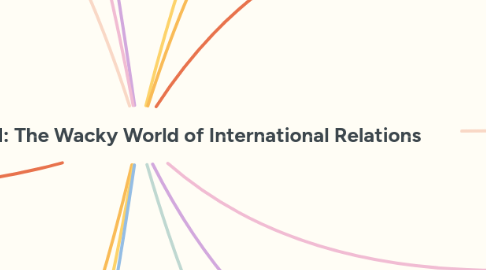
1. Women on IR
1.1. Born from the desire to inegrate women and their roles on the international system
1.2. Unless all the actors are involved, its imposible to get the complete picture about an issue
2. Nation-State
2.1. Nation: Group of people with similar background, culture, ethnicity and lenguage
2.2. State: Entity with a defined border under the rule of a goverment that is accepted by people
2.3. Concept originated in Europe traced to the "Peace of Westphalia"
2.3.1. In this treaty appears the concept of sovereignty: the goverment is the only legitimate autorithy within a given territory
3. The cold war as a game changer
3.1. Before: IR based on tied relationships between Nation-States
3.2. After 1991: No longer countries tied to USA or The Soviet Union, more fluid relations between states
3.3. Now: Integration of nation-states into larger regional blocks
3.3.1. Examples
3.3.1.1. European Union
3.3.1.2. BRICS +
4. Globalization phenomenon
4.1. Timeline according to Thomas Friedman
4.1.1. 1. 1492-1800 Voyage of Columbus: Where does my country fit into global competition?
4.1.2. 2. 1800-2000 2 World Wars: Birth of global economy
4.1.3. 3. 2000-Our days: Individuals and MNCs making a difference
4.2. Robert Marks: 3 primary trade routes
4.2.1. 1. East Asia linked to China and parts of Southeast to India
4.2.2. 2. Middle east-Mongolia: linked Eurasia to the eastern Mediterranean to central Asia and India
4.2.3. 3. European subsystem: Linked Europe to Middle East and the Indian Ocean
4.2.4. Marks also claims that the advent of Nationalism was conguent with the growth of idustrialization
4.3. Globalization also have the tendendy to be more and more demanding, not only of organizatins that control de expansion of relations but also natural resources (which slowly destroys our planet). The question here is: Does al the countries have the resources and money to adapt to this demanding system?
5. International Political Economy (IPE)
5.1. Study of the interrelationship between politics and economics between states and markets
5.2. How politics can be used to achive economic goals?
5.3. This raise questions about who controls who on the market and if its being fair with not developed countries.
5.3.1. A clear example of this is are Latin American countries who seems to be left behind with not so many useful decissions on the economic scene, just the ones that favors bigger economic blocks.
6. The "global playground"
7. As we can see, globalization has become the central focus of international studies. It brings cooperation, joint policies, and even the expansion of disasters such as conflicts between nations and pandemics, among others. I created the term "Global playground" as a metaphor based on the reading of "International Relations in a Globalized World," which presents not only positive factors but also the negatives of this growing phenomenon. In my personal opinion, there is currently no such thing as a homogeneous process of globalization, but rather a certain control by powerful state actors over others with less power, voice, and influence. Just like a playground, each child (country) is free to pursue their own strategies and alliances as they see fit, but there are always (or at least so far) parents (more developed countries) overseeing this process, seeking their own benefit from the ingenuity or needs of the others involved.
8. What is IR
8.1. Field of studies that deals with decisions made in a country that have implications for the countries nearby or the whole world
9. Interdependent
9.1. In the globalized world we live in, even the minor decisions made by a country has repercussions on the globe
9.1.1. Examples
9.1.1.1. September 11 attacks - Invasion of US forces in Afghanistan in October 2001
9.1.1.2. Nearby countries affected by the terrorist attacks of al-Qaeda
9.1.1.3. World economic crisis of 2007 and 2008
10. Why study IR
10.1. IR its the macro level of all the subfields of political science and international issues
10.1.1. It determines many aspects of our lives such as economics, public policies, external relations, cultural issues, among many others
10.1.2. Many parts involved: Goverments, Multinational corporations, nongovernmental organizations and international organizations
10.1.2.1. Examples
10.1.2.1.1. United nations
10.1.2.1.2. USA goverment
10.1.2.1.3. Green peace
10.1.2.1.4. Sheel
